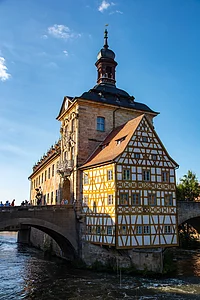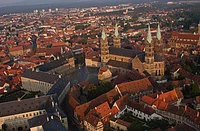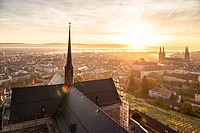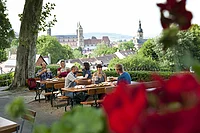Bamberg – Fascination World Heritage
Bamberg is a work of art. Barely any other city features such a kaleidoscope of architectural styles as this remarkable town.





Going in search of the past? In Bamberg, you can travel a thousand years back in time!
It was nothing short of a miracle that Bamberg emerged from all the major wars nearly unscathed. The entire architectural ensemble was the 13th monument in Germany and the 624th site in the world to be declared a UNESCO World Heritage Site back in 1993. It is a prime example of a central European city that has preserved its early mediaeval structure. It comprises three districts which in terms of their architecture, use and characteristics are all very different. These are the City on the Hills, the Island City and the Market Gardeners’ City whose ground plans all date back to the Early Middle Ages and are still visible to this day.
The World Heritage City of Bamberg thus boasts the largest, nearly fully intact old town ensemble in Germany and one of the most extensive in Europe.
Around 1000, Emperor Heinrich II. raised the city of Bamberg to the cultural, spiritual and strategic centre of Europe. For a short period of time, it even became the capital of the Holy Roman Empire of the German Nation. In the 17th and 18th centuries, Bamberg’s prince bishops lent the city its present-day, mostly baroque appearance, whilst preserving its old mediaeval foundations and fabric. Even so, this vibrant city is like a picture book of styles, featuring everything from Romanesque, Gothic and Renaissance to modern and contemporary architecture.
Examples of spectacular architecture in Bamberg’s city ensemble include the late Romanesque and Early Gothic Imperial Cathedral, which is endowed with four majestic spires, the Old Town Hall picturesquely perched in the middle of the river, the former Fishermen’s Settlement known as "Little Venice" and the lavish Baroque Palace “Böttinger House”. The town’s museums and collections, some of which are of European rank, offer plenty of stimulating and enriching experiences. Bamberg State Library, for example, holds several mediaeval manuscripts which, as documentary heritage, have long been part of the “UNESCO Memory of the World Register”. An abundance of art usually comes with a plethora of culture – and so it is in Bamberg. The famous Bamberg Symphony Orchestra, for example, acts as Bamberg’s cultural diplomat, spreading the city’s sparkling reputation to all four corners of the globe.
The wealth of art and culture can be seen and felt everywhere, be it in the summer months during the Art and Antiques Weeks, an event that draws a very specialised audience to Bamberg, or on a stroll through the city, stumbling across sculptures by Markus Lüpertz or Fernando Botero.
Besides the breathtaking architecture of the City on the Hills and the Island City, the third district within the boundaries of the World Heritage Site, the Market Gardeners’ City, is really quite unique. It is a prime example of urban market gardening that has its roots in the Early Middle Ages. “Bamberg’s market gardens” were added to the UNESCO List of Intangible Cultural Heritage in 2016. This lesser known district is something of an insider’s tip and can be extensively explored along the circular route through the Market Gardeners’ District and by visiting the Market Gardeners’ Museum. Those who appreciate fresh produce can buy recently harvested fruit and vegetables directly from the Market Gardens – including rarities and old local varieties such as the well-known “Bamberger Hörnla” potato for epicures.
Bamberg has another culinary distinction to its name as it has achieved worldwide acclaim as a City of Beer. Visitors are spoilt for choice with a wide an abundance of family-run breweries and a wide range of speciality beers – including varieties of the famous “Smoked Beer”, which has been brewed for centuries in keeping with age-old traditions.
The concerts by the Bamberg Symphony Orchestra, productions by the E.T.A. Hoffmann Theatre, the “Light and Shadow” play by Bamberg’s Shadow Theatre, the conjuror’s street festival “Bamberg zaubert” and the famous “Nativity City Bamberg” are just some of the special events held during the year.
Nestled in the beautifully lush Franconian countryside, Bamberg is the gateway to wonderful natural landscapes such as Franconian Switzerland and the Steigerwald Nature Park. Bamberg is situated in the middle of the city triangle Würzburg – Nuremberg - Bayreuth and boasts extremely good transport links, with direct access to the A70 and A73 motorways. The railway station is close to the city centre offering high-speed ICE connections to and from Munich and Berlin. Nuremberg airport is just 60 km away, with Munich and Frankfurt airports located around 220 km to the south and west of Bamberg respectively.
Touristic information and info on guided tours through the World Heritage:
BAMBERG Tourismus & Kongress Service
Geyerswoerthstrasse 5
96047 Bamberg
Tel. +49 (0) 951 2976 200
info@bamberg.info
www.bamberg.info

